VMware 5v0-41-20 practice test
VMware SD-WAN Troubleshoot Exam
Last exam update: Jul 20 ,2024
Question 1
Scenario 1:
A network administrator is tasked with enabling SO-WAN at three branch locations. A topology has
been provided for reference. For each site, the administrator is having issues bringing edges online,
as another administrator has gone ahead and created a configuration ahead of time. The
organization has several branch sites. One is an Internet-only site and two are Hybrid locations with
both internet and MPLS. The last location is MPLS only. There are hub data center locations in this
environment as well. Please refer to the topology.
After the network administrator has determined the problem with the Edge not being able to access
the Internet, the administrator receives another error stating that the SD-WAN Orchestrator is still
not reachable.
The VCO's address is Amer-vcoOl.velocloud.net.
Refer to the Exhibit(s).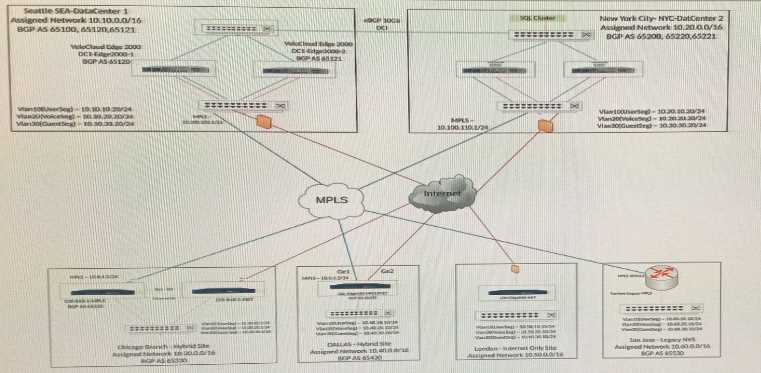
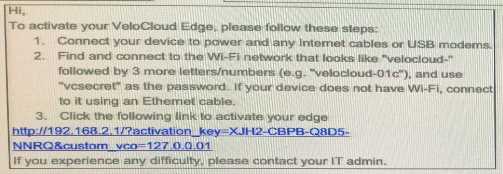
What might be disallowing the Edge to communicate with the Orchestrator?
- A. The SD-WAN Orchestrator specified is incorrect, and a new activation email needs to be sent.
- B. The local firewall that the Edge uses to reach externally is blocking UDP Port 53 in both directions.
- C. The SD-WAN Orchestrator has a limited 60-second window for the Edge to come online.
- D. The SD-WAN Orchestrator is not being resolved for DNS.
Answer:
C
Question 2
Scenario 2:
After completing the branch activation activities for all required branches, the network administrator
attempts to test connectivity between the various branches and between the hubs and branches.
The administrator notices a lack of connectivity despite being certain that configurations have been
complete. The administrator also observed that several users are reporting intermittent connectivity
to some of the applications they are accessing. Other users are reporting no access to these
applications. Other users at some of the branches claim they cannot get to certain public resources.
The administrator wants to ensure that all sites can talk to each other and all resources are
accessible.
Exhibit.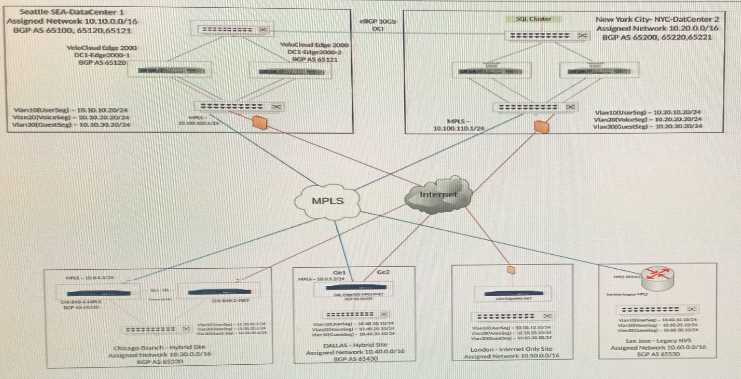
A network administrator is investigating connectivity issues between Chicago and San Jose. The
administrator browses to the Overlay Flow Control (OFC) window and notices that the screen is blank
with no routes shown in the OFC.
What is a possible reason for this?
- A. Cloud VPN for the Edges / Profiles is not enabled.
- B. There is an invalid MTU configuration at Chicago.
- C. OSPF or BGP is not enabled.
- D. The routing table on the Edges has not been initialized.
Answer:
A
Question 3
Scenario 1:
A network administrator is tasked! with enabling SO-WAN at three branch locations. A topology has
been provided for reference. For each site, the administrator is having issues bringing edges online,
as another administrator has gone ahead and created a configuration ahead of time. The
organization has several branch sites- One is an Internet-only site and two are Hybrid locations with
both internet and MPLS: The last location is MPLS only. There are hub data center locations in this
environment as well. Please refer to the topology.
Exhibit.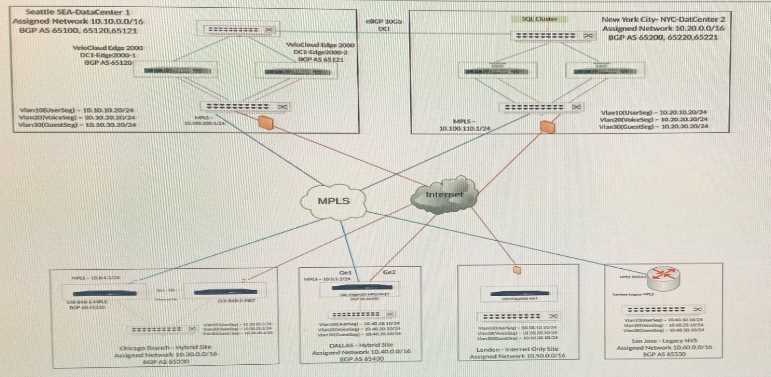
An administrator is attempting to activate two Edge devices at the Chicago branch location. The
local technician reports that the Edge devices are not coming online. The Edge devices have been
plugged in, powered on, and connected to the correct circuits with an Enhanced HA setup.
What should the local technician check first when troubleshooting the issue?
- A. Verify beep sequence of the Edge devices.
- B. Review color of the LED.
- C. Review the Orchestrator for HA misconfiguration issues.
- D. Verify the link light sequence of the HA ports.
Answer:
B
Question 4
Scenario 3:
After resolving numerous connectivity issues throughout the various branch sites, connectivity
between applications and users is finally present. The network administrator is informed that during
certain tests, applications are not performing as they are expected to. Users report that call quality
has not fully improved and that some of their calls either drop or have poor voice quality where the
conversation is breaking up. Other users are noticing that file transfers are slower than expect. A
group of users from a few sites have reported slowness in accessing internal and external
applications.
Exhibit.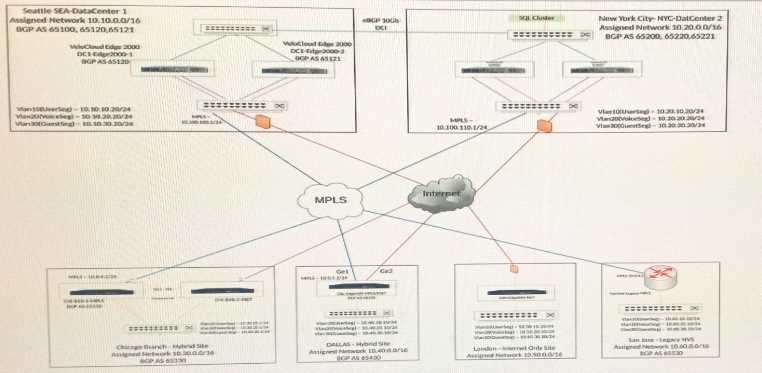
A network administrator is receiving complaints that a real-time voice application is not performing
well, with choppy audio, and dead audio especially during peak traffic times.
What two actions can the administrator take to diagnose and fix the issue? (Choose two.)
- A. Configure a QoS policy to rate limit all traffic during peak times.
- B. Ensure that the realtime application is matching the correct application type using the diagnostics page.
- C. Check the status of the links using the QoE and Transport tabs for any degraded underlay issues or congestion issues.
- D. Configure a QoS policy to load balance the realtime traffic across all links.
Answer:
A, C
Question 5
Scenario 3:
After resolving numerous connectivity issues throughout the various branch sites, connectivity
between applications and users is finally present. The network administrator is informed that during
certain tests, applications are not performing as they are expected to. Users report that call quality
has not fully improved and that some of their calls either drop or have poor voice quality where the
conversation is breaking up. Other users are noticing that file transfers are slower than expect. A
group of users from a few sites have reported slowness in accessing internal and external
applications.
Exhibit.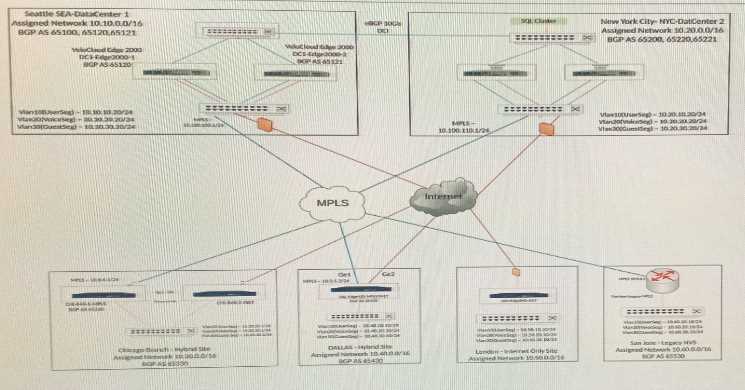
Users at the Dallas Branch are complaining that downloads/uploads from Office365 are slow.
Working in Teams has been providing slow responses. The Internet circuit is 100Mbps while the
MPLS Circuit is 45Mbps. Upon troubleshooting, the network administrator has noticed the traffic is
Backhauling through the Seattle hub for all internet traffic.
How should the network administrator resolve the issue?
- A. Leave the system as is, the gateways will resolve the issues after doing 15 minutes of link qualification.
- B. Advertise public routes to Office365 and Teams through the New York Hub.
- C. Leave the system as is, the hubs will auto-rebalance tunnels after doing 15 minutes of link qualification.
- D. Prevent the hub from advertising a default route.
Answer:
B
Question 6
Scenario 2:
After completing the branch activation activities for all required branches, the network administrator
attempts to test connectivity between the various branches and between the hubs and branches.
The administrator notices a lack of connectivity despite being certain that configurations have been
complete. The administrator also observed that several users are reporting intermittent connectivity
to some of the applications they are accessing. Other users are reporting no access to these
applications. Other users at some of the branches claim they cannot get to certain public resources.
The administrator wants to ensure that all sites can talk to each other and all resources are
accessible.
Exhibit.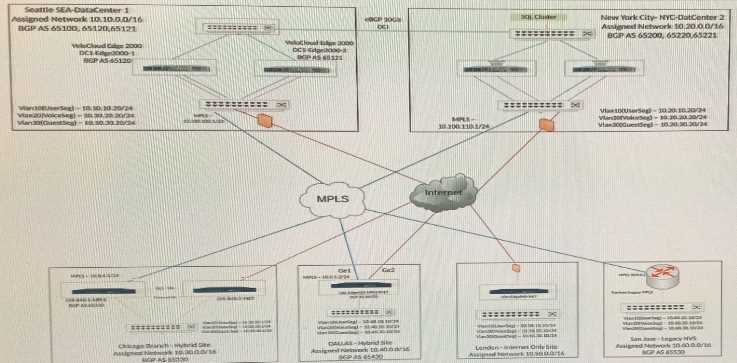
Where can the network administrator check to see what routes are present on the London-site Edge?
- A. Log into the VCO > Configuration > Overlay Flow Control
- B. Log into the VCO > Test & Troubleshoot > Remote Diagnostics > Run "List Paths"
- C. Log into the VCO > Test & Troubleshoot > Remote Diagnostics > Run "Route Table Dump"
- D. Log into the VCO > Monitoring > Overlay Flow Control
Answer:
C
Question 7
Scenario 3:
After resolving numerous connectivity issues throughout the various branch sites, connectivity
between applications and users is finally present. The network administrator is informed that during
certain tests, applications are not performing as they are expected to. Users report that call quality
has not fully improved and that some of their calls either drop or have poor voice quality where the
conversation is breaking up. Other users are noticing that file transfers are slower than expect. A
group of users from a few sites have reported slowness in accessing internal and external
applications.
Exhibit.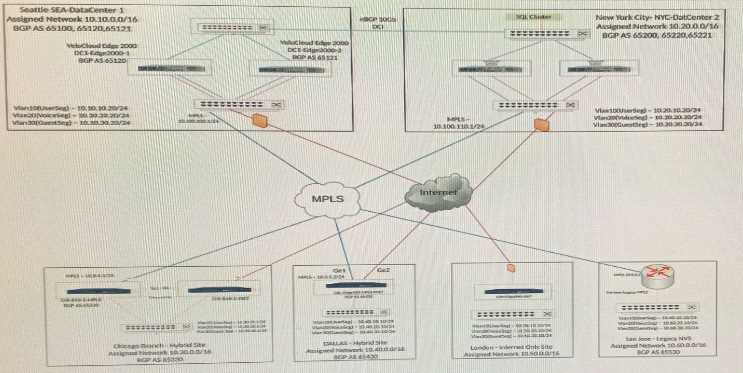
A network administrator wants to achieve better high-availability and network reconvergence
between LAN-side BGP Networks and the hub Edges in New York.
What must the administrator do?
- A. Modify the Keep Alive and Hold timers to the lowest possible values ensuring the Hold timer is 3 times more than the Keep Alive timer.
- B. Nothing, the system will auto-rebalance connections and will provide sub-second convergence.
- C. Modify the Connect and Hold timers to the lowest possible values ensuring the Hold timer is 3 times more than the Connect timer.
- D. Modify the Keep Alive and Hold timers to the lowest possible values ensuring the Keep Alive timer is 3 times more than the Hold timer.
Answer:
B
Question 8
Scenario 1:
The Dallas Branch location is having issues getting activated. The local network administrator is
aware that the Edge device received a DHCP address and was able to connect to the internet. The
Orchestrator is reporting the Edge as Down. No other changes were made post activation.
A network administrator is tasked with enabling SD-WAN at three branch locations. A topology has
been provided for reference. For each site, the administrator is having issues bringing edges
online, as another administrator has gone ahead and created a configuration ahead of time. The
organization has several branch sites. One is am Internet-only site and two are Hybrid locations with
both internet and MPLS. The last location is MPLS only. There are hub data center locations in this
environment as well. Please refer to the topology.
Refer to the Exhibit(s).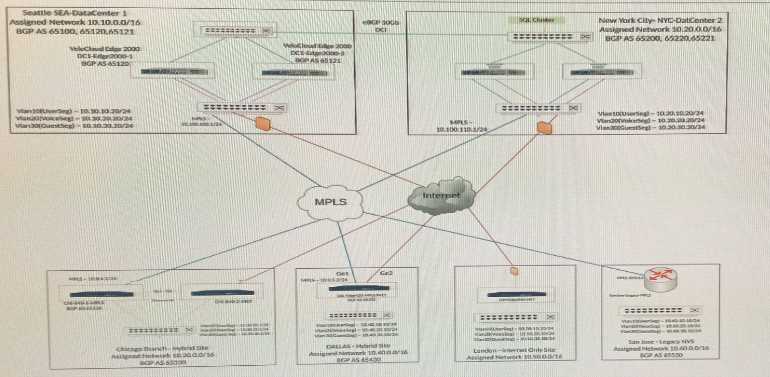
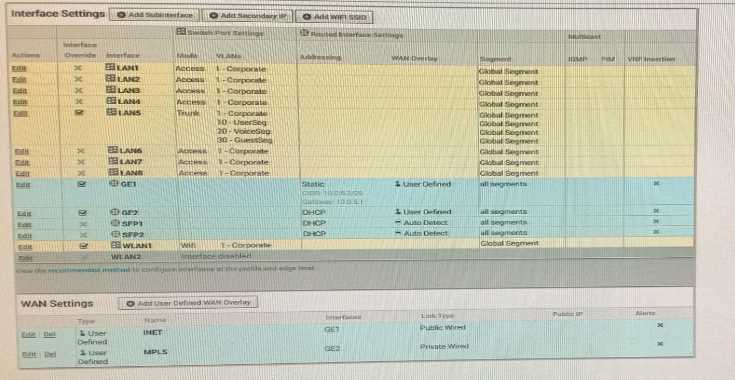
What is the cause of this issue?
- A. The activation link did not specify the updated image location requiring the Edge to be re- activated.
- B. The activation link did not contain any post-activation configuration to allow the Orchestrator to communicate with the Edge.
- C. The Edge will be offline for about 4 hours until it has completed the factory image installation.
- D. The activation link contained incorrect configurations for WAN overlays and WAN interfaces.
Answer:
A
Question 9
Scenario 2:
After completing the branch activation activities for all required branches, the network administrator
attempts to test connectivity between the various branches and between the hubs and branches.
The administrator notices a lack of connectivity despite being certain that configurations have been
complete. The administrator also observed that several users are reporting intermittent connectivity
to some of the applications they are accessing. Other users are reporting no access to these
applications. Other users at some of the branches claim they cannot get to certain public resources.
The administrator wants to ensure that all sites can talk to each other and all resources are
accessible.
Exhibit.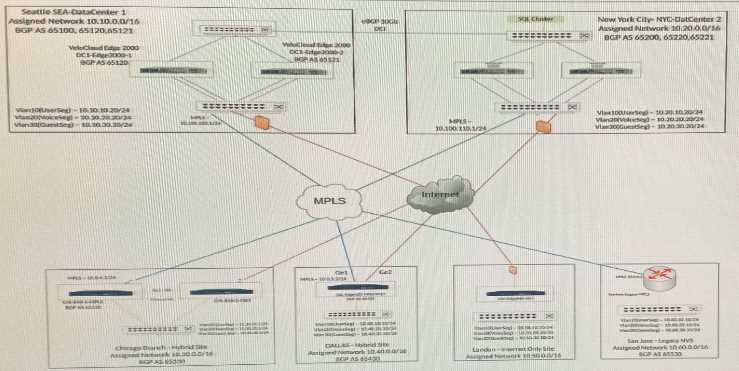
When checking connectivity from the San Jose branch, all users report that they can reach certain
resources at the main data center. They are unable to reach locations elsewhere. The network
administrator investigates and first looks at the Overlay Flow Control (OFC) Table.
What should the network administrator look for next to determine what the issue might be?
- A. Check with the local network administrator to see if the routes for the SD-WAN sites are present in San Jose's branch router.
- B. Check Test & Troubleshoot and review a route table dump of the NY hub site.
- C. Check the Global Segment Configuration to see if it has the Routing Flag enabled.
- D. Determine if OSPF has been configured on the MPLS Routers at the hub.
Answer:
C
Question 10
Scenario 3:
After resolving numerous connectivity issues throughout the various branch sites, connectivity
between applications and users is finally present. The network administrator is informed that during
certain tests, applications are not performing as they are expected to. Users report that call quality
has not fully improved and that some of their calls either drop or have poor voice quality where the
conversation is breaking up. Other users are noticing that file transfers are slower than expect. A
group of users from a few sites have reported slowness in accessing internal and external
applications.
Exhibit.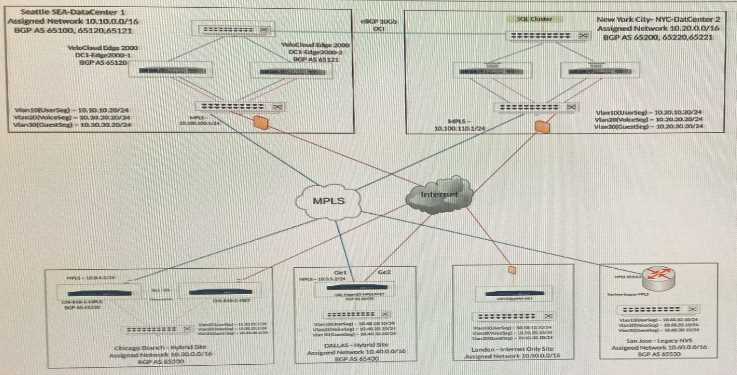
A network administrator decides to deploy a local Checkpoint VNF appliance on the Edge in London
to cut back on unnecessary traffic towards the NY hub location.
The Checkpoint VNF and associated security services were successfully deployed at the London
Branch. Users are now are complaining that Webpages are extremely slow to load, just like before.
What should the administrator do?
- A. Reboot the Edge, as this is a requirement in the deployment of a Security VNF.
- B. Disable and redeploy the VNF with lower memory requirements.
- C. Verify to see if a firewall rule in the Edge is set to allow traffic to the Checkpoint VNF.
- D. Check the flow records in Remote Diagnostics.
Answer:
B
Question 11
Scenario 2:
After completing the branch activation activities for all required branches, the administrator
attempts to test connectivity between the various branches and between the hubs and branches-
The administrator notices a lack of connectivity despite being certain that configurations have been
complete. The administrator also observed that several users are reporting intermittent connectivity
to some of the applications they are accessing. Other users are reporting no access to these
applications. Other users at some of the branches claim they cannot get to certain public resources.
The administrator wants to ensure that all sites can talk to each other and all resources are
accessible.
Exhibit.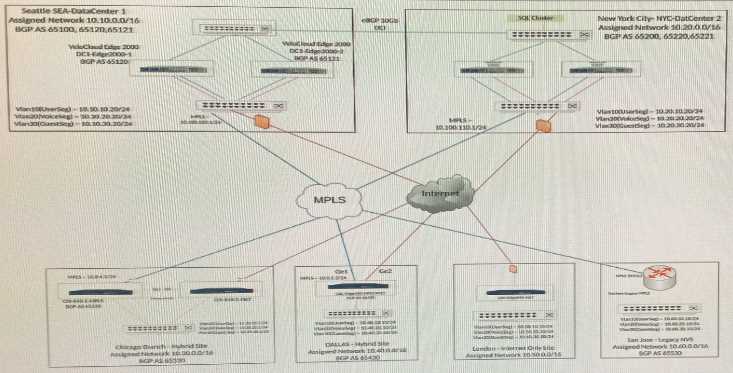
The tunnel from the Dallas site to the Seattle hub is not coming up.
What are two things that should be checked to determine the issue? (Choose two.)
- A. Hub WAN Interface might be behind a firewall.
- B. Spoke Edge and Hub Edge have a mismatched certificate.
- C. Dynamic Branch to Branch is not enabled.
- D. Spoke Edge and Hub Edge are two different Edge models.
Answer:
AB
Question 12
Scenario 2:
After completing the branch activation activities for all required branches, the network administrator
attempts to test connectivity between the various branches and between the hubs and branches.
The administrator notices a lack of connectivity despite being certain that configurations have been
complete. The administrator also observed that several users are reporting intermittent connectivity
to some of the applications they are accessing. Other users are reporting no access to these
applications. Other users at some of the branches claim they cannot get to certain public resources.
The administrator wants to ensure that all sites can talk to each other and all resources are
accessible.
Exhibit.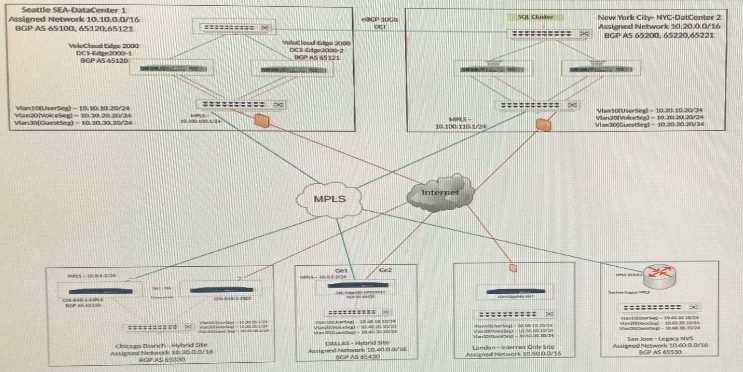
A network administrator decides to deploy a local Checkpoint VNF appliance on the Edge in London
to cut back on unnecessary traffic towards the NY Hub location. While attempting to deploy the VNF,
the process keeps failing.
Where can the administrator check to see more detail?
- A. VCO > Monitor > Logging
- B. VCO > Monitor > Events
- C. VCO > Test & Troubleshoot > Remote Diagnostics > Events
- D. VCO > Test & Troubleshoot > Remote Actions > Alerts
Answer:
B
Question 13
Scenario 2:
After completing the branch activation activities for all required branches, the network administrator
attempts to test connectivity between the various branches and between the hubs and branches.
The administrator notices a lack of connectivity despite being certain that configurations have been
complete. The administrator also observed that several users are reporting intermittent connectivity
to some of the applications they are accessing. Other users are reporting no access to these
applications. Other users at some of the branches claim they cannot get to certain public resources.
The administrator wants to ensure that all sites can talk to each other and all resources are
accessible.
Exhibit.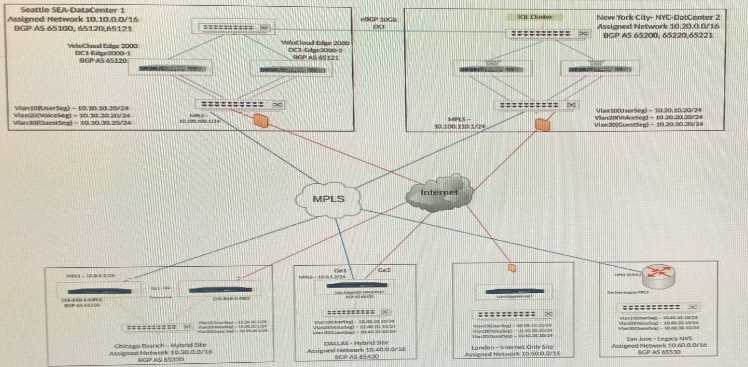
The tunnel from spoke to hub is not coming up. What are the two possible reasons? (Choose two.)
- A. Spoke Edge and hub Edge are two different Edge models.
- B. Spoke Edge and hub Edge have a mismatch certificate authentication mode.
- C. Hub WAN Interface might be behind the NAT Device or firewall.
- D. Dynamic Branch to Branch is not enabled.
Answer:
B, C
Question 14
Scenario 3:
After resolving numerous connectivity Issues throughout the various branch sites, connectivity
between applications and users is finally present- The network administrator is informed (hat during
certain tests, applications are not performing as they are expected to. Users report that call quality
has not fully improved and that some of their calls either drop or have poor voice quality where the
conversation is breaking up. Other users are noticing that file transfers are slower than expect. A
group of users from a few sites have reported slowness in accessing internal and external
applications.
Exhibit.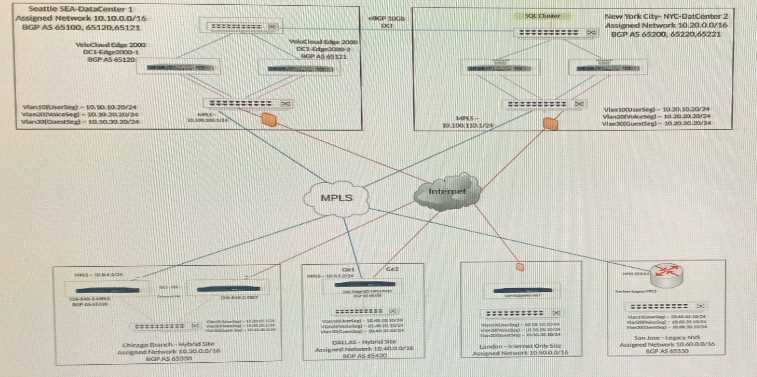
Which metrics can a network administrator verify in the QoE screen to determine the overall health
of Underlay and Overlay?
- A. Jitter Packet Loss, Speed.
- B. Jitter, Packet Loss, Latency.
- C. Jitter, Speed, Latency.
- D. Packet Loss, Latency, Speed.
Answer:
B
Question 15
Scenario 3:
After resolving numerous connectivity Issues throughout the various branch sites, connectivity
between applications and users is finally present. The network administrator is informed that during
certain tests, applications are not performing as they are expected to. Users report that call quality
has not fully improved and that some of their calls either drop or have poor voice quality where the
conversation is breaking up. Other users are noticing that file transfers are slower than expect. A
group of users from a few sites have reported slowness in accessing internal and external
applications.
Exhibit.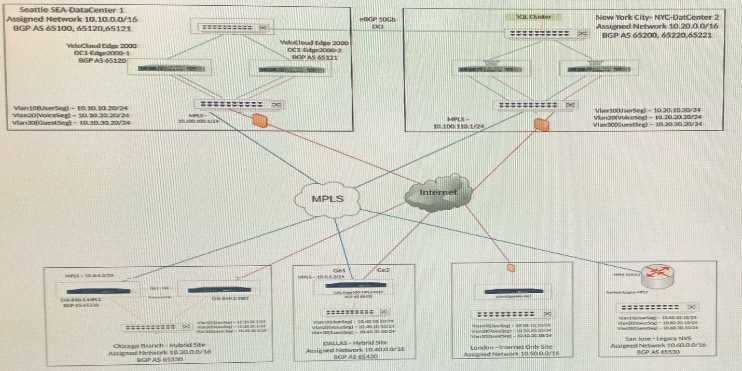
Users at a remote office are complaining about poor performance with certain applications. The
network administrator has already verified the configuration is correct.
Which two parameters should the administrator review to troubleshoot this issue? (Choose two.)
- A. Check the underlay network (bandwidth, latency, jitter, packet loss)
- B. Change the bandwidth measurement under WAN Overlay Advanced Settings
- C. Check the flows to verify which Business Policy the traffic of interest is matching
- D. Look under Monitor, check Business priority tab
Answer:
A, D